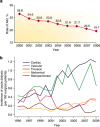The growth of acute kidney injury: a rising tide or just closer attention to detail?
- PMID: 25229340
- PMCID: PMC4281297
- DOI: 10.1038/ki.2014.293
The growth of acute kidney injury: a rising tide or just closer attention to detail?
Abstract
Acute kidney injury (AKI), previously termed acute renal failure, is associated with increased mortality, prolonged hospital stay, and accelerated chronic kidney disease (CKD). Over the past 2 decades, dramatic rises in the incidences of AKI have been reported, particularly within the United States. The question arises as to whether these changes reflect actual increases in disease incidence, or are potentially explained by the introduction of consensus definitions that rely on small standardized changes in serum creatinine, changes in coding and reimbursement, or increasingly available and more liberal use of dialysis. In this review, we explore the secular trends in AKI incidence in North America and Western Europe and its potential contributors.
Figures




Comment in
-
The growth of acute kidney injury: Eastern European perspective.Kidney Int. 2015 Jun;87(6):1264. doi: 10.1038/ki.2015.61. Kidney Int. 2015. PMID: 26024040 No abstract available.
References
-
- Swan RC, Merrill JP. The clinical course of acute renal failure. Medicine. 1953;32:215. - PubMed
-
- Smith HJ.The Kidney: Structure and Function in Health and Diseasefourth printingOxford University Press: London, England; 1964810
-
- Uchino S, Kellum JA, Bellomo R, et al. Acute renal failure in critically ill patients: a multinational, multicenter study. Jama. 2005;294:813–818. - PubMed
-
- Mehta RL, Pascual MT, Soroko S, et al. Spectrum of acute renal failure in the intensive care unit: the PICARD experience. Kidney Int. 2004;66:1613–1621. - PubMed
Publication types
MeSH terms
Grants and funding
LinkOut - more resources
Full Text Sources
Other Literature Sources
Medical
Miscellaneous

